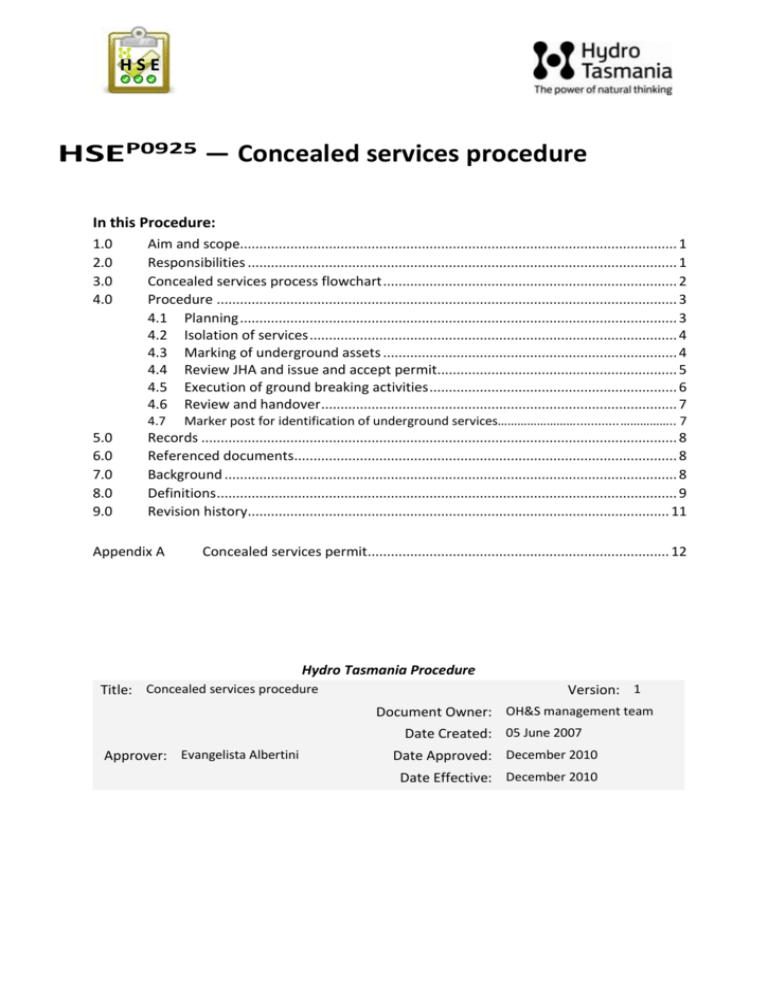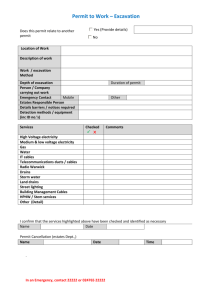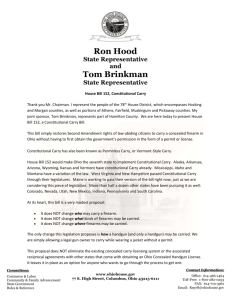HSEP09XX Concealed services procedure
advertisement

HSE HSEP0925 – Concealed services procedure In this Procedure: 1.0 2.0 3.0 4.0 Aim and scope................................................................................................................. 1 Responsibilities ............................................................................................................... 1 Concealed services process flowchart ............................................................................ 2 Procedure ....................................................................................................................... 3 4.1 Planning ................................................................................................................. 3 4.2 Isolation of services ............................................................................................... 4 4.3 Marking of underground assets ............................................................................ 4 4.4 Review JHA and issue and accept permit.............................................................. 5 4.5 Execution of ground breaking activities ................................................................ 6 4.6 Review and handover ............................................................................................ 7 4.7 5.0 6.0 7.0 8.0 9.0 Marker post for identification of underground services…………………… ............ …………….. 7 Records ........................................................................................................................... 8 Referenced documents................................................................................................... 8 Background ..................................................................................................................... 8 Definitions ....................................................................................................................... 9 Revision history............................................................................................................. 11 Appendix A Concealed services permit.............................................................................. 12 Hydro Tasmania Procedure Title: Concealed services procedure Version: 1 Document Owner: OH&S management team Date Created: 05 June 2007 Approver: Evangelista Albertini Date Approved: December 2010 Date Effective: December 2010 HSE 1.0 Health, Safety & Environment - HSEP0925 – Concealed Services Procedure Revision 2 CAUTION: Printed Document is Uncontrolled Print Date: 13/02/2016 Aim and scope The aim of this procedure is: To detect concealed services before the commencement of works. Maintain safety of personnel and concealed services and assets during ground breaking or drilling activities. This procedure shall apply to works undertaken on all Hydro Tasmania assets and work sites. 2.0 Responsibilities Responsible Officer The Responsible Officer is accountable to provide the necessary resources to ensure safe systems of work that ensure this procedure is understood, applied and observed within their area of authority. Manager occupational health and safety The manager occupational health and safety is responsible for: Ensuring that training material is current and of an appropriate quality. Ensuring safety systems are kept up to date in relation to this procedure. Recording and analysing incident / investigation data. Ensuring that this procedure is reviewed as stipulated. Line managers Have the responsibility for the management or control of a work place, within their area of authority, and must ensure this procedure is implemented. They shall maintain a hazard and risk register and appropriate signage for their work place; and shall ensure that competent and accountable persons assigned for the management and execution of work within their area of authority, conduct appropriate Risk Assessments. Accountable person Has the responsibility for following this procedure and ensuring those working under their control follow this procedure. They have responsibility for the safety of personnel following this procedure and for maintaining appropriate records relating to their activities. Line managers, asset owners and their delegates, job managers, site managers and project managers, authorised issuing officers and persons in charge are all examples of accountable persons. Employee / contractor Are required to act in a manner that does not adversely affect their own health and safety, or that of others. They may be instructed persons and shall comply with the terms of this procedure and must immediately report to the accountable person any matter that may affect their own or others' health and safety. Page 1 of 12 HSE 3.0 Health, Safety & Environment - HSEP0925 – Concealed Services Procedure Revision 2 CAUTION: Printed Document is Uncontrolled Print Date: 13/02/2016 Concealed services process flowchart HAND OVER PHASE Excavation or penetration required AP reviews drawings of site AP contacts 'Dial before you dig' as appropriate HT DBYD requestor response procedure activated Competent Person inspects site to identify concealed services Yes Exploratory holes adequate? No Yes No Can all services be identified? Yes Local electronic survey adequate? WORK PHASE HAND BACK PHASE AP acknowledges receipt of Permit & reviews Permit & JHA with work team Excavation or penetration carried out PIO signs off work PIO endorses JHA & approves & issues Permit to AP AP uses checklist to ensure on-going safety PIO collects originals of JHA, permit, markedup drawings, signed checklist PIO lists any Special Conditions AP marks up drawing(s) to capture changes AP submits permit to PIO PIO may decide to inspect site and/ or approves backfill AP prepares JHA with work team AP arranges for backfill in accordance with listed conditions PIO sends marked up drawings to Drawing Manager & GIS Administrator PIO arranges for hardcopy storage of documentation with Work Order End AP completes Request for Permit' & Planning section No AP arranges for professional electronic survey to be carried out AP prepares marked-up drawing(s) AP marks services & Limits of approach Page 2 of 12 HSE Health, Safety & Environment - HSEP0925 – Concealed Services Procedure Revision 2 CAUTION: Printed Document is Uncontrolled Print Date: 13/02/2016 4.0 Procedure 4.1 Planning As far as is reasonably practicable, prior to the commencement of any excavation or penetration, the precise location of all concealed services, buried pipe work, structures, foundations, electrical equipment, cabling, or hazardous materials, shall be identified and clearly marked to prevent damage during the work. Undertake the following searches/documentation for concealed services until all services are positively located: 1. Copy of drawings of known concealed services in the area. 2. Regardless of whether dig-site is on Hydro Tasmania property or not: i. Go to ‘Dial Before You Dig’ website and submit details of dig-site into their online request form (www.dialbeforeyoudig.com.au). ii. ‘Dial Before You Dig’ will contact utilities that have known underground assets within the vicinity of the dig-site. iii. The utility (or utilities) will respond directly to the requestor by electronic or hard copy means (may be by post) within 48 hours of receipt of the referral, providing detailed location of any known underground services within the vicinity. iv. The utility may decide to send a representative to the site to ensure that any activity avoids damage to their services. v. Accountable person to allow a minimum of five days prior to proposed work to allow for information to be received. NOTE: Some insurance companies are now refusing to cover policy-holders that do not use ‘Dial Before You Dig’ and subsequently damage a service. 3. Contact the asset owner’s representative or other knowledgeable person as part of the work planning process. 4. Inspection of the site by a competent person checking for locations of possible concealed services and looking for the following: 5. i. A direct or indirect route between the source and the load. ii. Markers on the surface. iii. Between stop valves/pits. iv. Earthing, including the earth mat, cabling and pipes entering the ground. v. Service pipe work between two buildings. vi. Conduits, switches or terminal boxes on the other side of the structure. vii. Disturbance of ground, slab or wall that suggests presence of concealed service. Note: Optical fibre cable may not be able to be detected by a site survey. Identification of this cable on drawings, ensuring that cables coordinates are registered on the Hydro’s GIS database and entering the cable as a hazard on the appropriate site workplace registers should ensure that these cables are identified prior to commencing work at a dig site. Carry out non-mechanical removal of material to initially identify services. Page 3 of 12 HSE Health, Safety & Environment - HSEP0925 – Concealed Services Procedure Revision 2 CAUTION: Printed Document is Uncontrolled Print Date: 13/02/2016 6. Conduct a survey of the proposed excavation/penetration area using electronic locating devices. There are various types of commercially available locating devices (see Section 8 for some service providers). Note: The best way to eliminate risk is to physically locate the service by non-mechanical removal of material. No excavation/penetration shall be performed on site before an approved concealed services permit has been issued. A job hazard analysis (JHA) shall be prepared by the workgroup prior to an excavation after the concealed services checklist has been complete. All hazards not covered off in the checklist must be covered within the JHA. A confined space permit is required if the excavation meets the definition of a confined space. For trenching requirements refer to reference documents. When no one is in attendance, adequate covers are to be used to cover the trench to prevent persons falling into an excavation where the depth is two metres or more. To prevent machinery getting closer than the distance equal to 1.5 times the height of the excavation, webbing barricade firmly supported by star pickets shall be installed at the appropriate distance from the excavation perimeter. When excavating by mechanical means, a safety observer shall be present, to oversee trenching activities, and to be alert to; any pipes/cables that have been partially exposed, trench collapse or personal risk and to be able to stop activities immediately. The depth of services and presence of multiple services in the same trench shall be determined. The following removal of material methods shall be used; Outside one metre of a ‘positive service location’ (i.e. by exposure or using an electronic location device) of a concealed service, ‘mechanical removal of material’ can proceed Within one metre of a ‘positive service location’ of a concealed service, only ‘non-mechanical removal of material’ shall be used. 4.2 Isolation of services Where possible all underground assets must be isolated during ground breaking activities. Where isolations are not used, the asset and appropriate mitigation actions must be stipulated within the JHA. Some examples of other mitigation measures are covered in ‘execution of ground breaking activities section. 4.3 Marking of underground assets As part of the preparation of the excavation permit, identification of concealed services is critical to ensure that no workers are exposed to any risk of injury and/or the company is not exposed to financial risk. The accountable person shall conduct a review of relevant drawings to determine the existence, and precise location, of all concealed services, buried pipe work, structures, foundations, and electrical cabling in the vicinity of the proposed work perimeter. A marked-up drawing of the proposed excavation/penetration shall be attached to assist the review process. Page 4 of 12 HSE Health, Safety & Environment - HSEP0925 – Concealed Services Procedure Revision 2 CAUTION: Printed Document is Uncontrolled Print Date: 13/02/2016 Once a service is identified, the ground shall be marked with a coloured line to indicate conductors, cables and pipelines using a clearly visible spray paint. The required colours are: Power conductors Orange Telecommunication cables Yellow Stormwater, drainage Green Water Blue Sewer Red Limits of approach for mechanical and Silver non-mechanical removal of material Gas main – contact the local gas distributor to arrange for a site inspection and clearance to proceed. A marked up drawing of the proposed excavation shall be prepared. 4.4 Review JHA and issue and accept permit This procedure assumes that a concealed services permit is required unless deemed unnecessary by the JHA. A requirement for a permit cannot be removed by a JHA for locations in and around stations, built-up areas, switchyards, major dams i.e. where there is potential for concealed services. An accountable person using a JHA to remove the need for a permit shall be deemed competent by their line manager to make this decision. If there is potential for impact on the environment e.g. world heritage, oil spills, weed contamination, contact the environmental compliance officers to determine the need for an environmental impact assessment. The accountable person will complete the Request for Permit and Planning details of the concealed services permit (see Appendix A) and submit it to the nominated authorised issuing officer (AIO), before the planned commencement of the excavation work. The accountable person shall, in conjunction with the AIO, review the location of the proposed work perimeter, and check all relevant drawings to identify concealed services. Following the review of drawings, identification and marking of any additional concealed services, the AIO will list any special conditions necessary for the safe performance of the work. Such conditions may include, but are not limited to: a) Hand digging to locate and secure services. b) The isolation of electrical services. c) The requirement to have additional supervisory, or specialist, personnel present. d) Not using mechanical digging equipment. e) Substituting bucket teeth with a scraping blade. f) The requirement for inspections of the excavation/penetration before and during the performance of the work. g) Potential contamination e.g. asbestos, high-pressure liquids. Compliance with the conditions listed on the permit is a condition of issue and acceptance of the permit. The AIO in consultation with the accountable person will record any ‘conditions of permit Issue’. Page 5 of 12 HSE Health, Safety & Environment - HSEP0925 – Concealed Services Procedure Revision 2 CAUTION: Printed Document is Uncontrolled Print Date: 13/02/2016 These conditions along with risk assessments and control measures shall be incorporated into the JHA for the task and the AIO will endorse/sign and date the JHA. The AIO shall then issue the permit. The accountable person for the work shall sign and accept the permit, and ensure that the work is completed in accordance with any conditions listed on the permit. The accountable person will explain the conditions of the permit to all personnel performing the work in the initial work team and those that join later. The concealed services permit and JHA shall be displayed at the location of the work, or be in possession of a person at the job site, at all times. The approval and issue of the concealed services permit is to ensure that no concealed services are damaged during the excavation. It does not detail the safe method of performing the task. These shall be covered in the JHA or standard work instruction. 4.5 Execution of ground breaking activities The concealed services permit and JHA shall give warning of all known hazards and any uncertainties over the hazards that might be present. Exploratory digs shall be carefully specified. Where a risk assessment indicates there is a risk of exposure to a hazard from a service, then that service should be isolated, locked and tagged out. If this is not reasonably practicable, use: earth leakage circuit breakers on power leads double insulated electrical tools electrically-rated protective gloves electrically rated footwear rubber mats As identified by the risk assessment. Any penetration of a building surface shall adopt these principles: Determine if penetration can be avoided. Penetrate no deeper than is required to do the job. Check drill holes frequently for signs of obstructing materials, such as wire fragments. If you hit an obstruction, stop and investigate. If penetration location or work requirements change, ensure that the concealed services permit is reviewed with the AIO and that potential hazards are evaluated. Drill pilot holes. Ensure that the proper drilling or cutting equipment is prescribed for the job. Once concealed services have been located, they shall be marked. Ensure personnel are competent to use electronic devices to detect concealed services. Never rely on the actuation of electrical circuit breakers as a safety barrier for personnel. When procedures or work plans appear to be inconsistent with actual conditions, stop work and notify the accountable person. Page 6 of 12 HSE Health, Safety & Environment - HSEP0925 – Concealed Services Procedure Revision 2 CAUTION: Printed Document is Uncontrolled Print Date: 13/02/2016 The concealed services checklist shall be used throughout the task to ensure that good work practices are followed. On completion of the task, the checklist shall be signed, dated and given to the AIO along with the permit and JHA. Excavation/penetration presents a range of hazards, including but not limited to: 1. Damage to buried electric cables, pipes, or equipment. 2. Damage to structures or foundations. 3. Accumulation of liquids or vapours, which might lead to flooding, explosion, asphyxiation, or harm to the health of personnel. 4. Caving-in due to inadequate shoring, or to super-loading around the edges of the excavation. 5. Subsidence of adjacent areas. 6. Personnel or objects falling into the workings. 7. Confined spaces. 8. Dust. 9. Loss of continuity of supply. 10. Struck by plant. Backfilling requirements 1. Large masses of fill shall not be placed in such a way to cause damage to an underground service. 2. Backfill beneath and around an underground service shall be properly compacted in accordance with generally accepted engineering practice. 3. Heavy loads and excessive force shall not be imposed on any exposed underground service at any time during backfilling operations. 4.6 Review and handover It is essential that up to date records be maintained, during the project, of any services or facilities that are to be covered. Upon completion of the excavation/penetration, and prior to the backfilling of any trench where services have been laid, the accountable person of the work shall contact the AIO, and provide location a marked-up drawing of all installed services. A copy of these marked up drawings shall be provided to Hydro Tasmania’s GIS administrator. The asset location will then be incorporated into the appropriate GIS layer to assist with future DIAL BEFORE YOU DIG referrals. The AIO may wish to inspect the excavation prior to approving backfill on the concealed services permit. The AIO shall then complete the approval to backfill of the permit. 4.7 Marker post for identification of underground services As well as up to date records bring maintained, it may be identified as part of a project or as a result of inadvertent digging up of underground services that they be clearly signposted and marked. Where this is identified the following markers shall be considered. As Hydro Tasmania have a number of services that may require marking e.g. fibre optic, power, communications, water etc. the following sticker and post has been made as a general warning and indication that services are in the area and that Hydro Tasmania Page 7 of 12 HSE Health, Safety & Environment - HSEP0925 – Concealed Services Procedure Revision 2 CAUTION: Printed Document is Uncontrolled Print Date: 13/02/2016 should be contacted directly or indirectly through “Dial Before You Dig” of which Hydro Tasmania is a member. Sticker 85mmx125mm courtesy of “Euro Signs” 5.0 Steel Dura-Post www.post.com.au Records Concealed services permit Concealed services checklist Job hazard analysis Environmental impact assessment if required The AIO will collect the originals of the above records and arrange for them to be stored with work order or project documentation. Changes to services shall be marked up on a drawing by the AP and submitted to the Hydro Tasmania Drawing Manager by the AIO 6.0 Referenced documents Code of Practice No.8 – Safety precautions in trenching operations (Victoria) Guidelines – Construction industry (Tasmania) Concealed services permit Safe work practices handbook 7.0 Background External Service Providers – but not limited to: Underground Asset Services 0418 124 564 AUS Archers Underground Services 0418 737 299 Tasmanian Cable Locators 0417 546 496 Page 8 of 12 HSE Health, Safety & Environment - HSEP0925 – Concealed Services Procedure Revision 2 CAUTION: Printed Document is Uncontrolled Print Date: 13/02/2016 8.0 Definitions Asset Owner (AO) a person delegated by the RO, who is in charge of a facility or work site; and is in control of the approval of all work (permitted or otherwise) to be conducted at the facility or work site. The AO must ensure co-ordination of all work on their facility or work site. Accountable person (AP) an individual, who assumes responsibility for the health and welfare of any other person in a workplace by providing instruction, direction, assistance, advice or service, is deemed an accountable person in accordance with the Workplace Health & Safety Regulations 1998. All management and supervisory staff (which include those with responsibility for students) are therefore considered “accountable persons”. An employee authorised by Hydro Tasmania, who acts on behalf of the asset owner to issue permits for approved work; and who is qualified, and authorised to give permission to commence work and accept the hand back of the work site. Authorised issuing officer (AIO) Competent person A person who has, through a combination of training, education, assessment and experience, acquired knowledge and skills to correctly perform a specified task. Mechanical removal of material by use of powered or heavy equipment such as drills, circular saw, jack hammer, boring equipment, coring equipment, concrete saw, pick, backhoe, or any power excavation machine. a survey of concealed services conducted by a competent person using an electronic locating device The digging of an area by manual means (pick, shovel, crowbar), the use of mechanical excavation equipment (backhoe, trenching machine, excavator, ditch witch) to dig at any depth, the driving into the ground of any piles, posts, spikes and “star pickets” or the drilling or cutting into a surface including walls, ceilings and roofs within the project site. is the process and document used to record hazards of all types, job steps and appropriate control measures to manage the identified risks a role taken on by a person responsible for the safe delivery of a scope of work. This person may take on the role and responsibilities of PIC where a permit to work is required Electronic site survey Excavation / penetration JHA Job manager Line manager an employee (Hydro Tasmania or contractor), who holds authority in a vertical 'line' (chain of command) and to who queries or approvals can be addressed. Examples: A JHA with a controlled risk level of high requires approval by a line manager. Non-mechanical removal of material Reasonably practicable by use of vacuum, or excavated with appropriate safe technology, such as an air knife, shovel, vacuum, pneumatic chipping gun with a spade bit, breaker bar or high pressure water excavation an assessment is made by the accountable person in which the magnitude of risk is placed on one scale and the sacrifice in the measures necessary to avert the risk (i.e. money, time or trouble) is placed on the other. Factors that must be considered are: the likelihood of a person being exposed to harm; the potential seriousness of that harm; what is known, or ought to be known, about the risk; Page 9 of 12 HSE Health, Safety & Environment - HSEP0925 – Concealed Services Procedure Revision 2 CAUTION: Printed Document is Uncontrolled Print Date: 13/02/2016 Services Safety observer how to eliminate the risk; and the availability, suitability and cost of eliminating or reducing the risk. Concealed assets including but not limited to pipes, conduits and cables whether in-service (live) or out of service that could be in or near the area of excavation. A competent person specifically instructed in their duties on each occasion. Any safety observer appointed SHALL be appropriately skilled in all respects of safety observation and be fully aware of the potential risks associated with the work. Examples of where used: Confined space Hot work Work in vicinity of H.V. Excavation / concealed services Page 10 of 12 HSE 9.0 Revision number Health, Safety & Environment - HSEP0925 – Concealed Services Procedure Revision 2 CAUTION: Printed Document is Uncontrolled Print Date: 13/02/2016 Revision history Date approved Detailed revision description Document owner Document approver Jack Lawson, Craig Emmett, Ken French, Rob Williams, Hayden Foley Boyd Leedham and Mick Cuppari Evangelista Albertini 05 June 2007 Original document created 1 Dec 2010 Critical procedures review supersedes Document ID: DMS73732 Deleted and added information in section 1.0 and 4.5 Added information in section Mick Cuppari 4.1 and 4.2 Deleted information in section 4.3, 4.4 and 4.6 Changed safe work practices checklist to concealed services checklist in section 6.0 Critical procedure review team. 2 September 2012 Marker post for identification Mick Cuppari of underground services added. Bruce Hill and Mick Cuppari Adam Rosevear 0 Peter Collidge Document reviewer Page 11 of 12 HSE Health, Safety & Environment - HSEP0925 – Concealed Services Procedure Revision 2 CAUTION: Printed Document is Uncontrolled Print Date: 13/02/2016 Appendix A Concealed services permit Page 12 of 12






